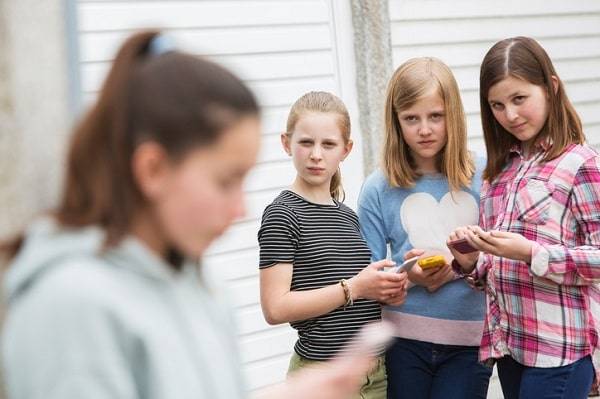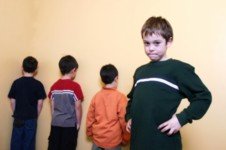Machiavellian kids? Understanding the moral reasoning of bullies

© 2021 Gwen Dewar, Ph.D., all rights reserved

Far from being social oafs, many bullies are confident, popular, and socially-savvy. So what’s missing? Empathy, moral engagement, and a sense of responsibility towards others.
According to an old stereotype, people bully others because they have poor self-esteem and lack basic social skills. They don’t know how to get what they want through negotiation, so they use aggression instead.
Is it true?
Maybe — for some individuals. But many bullies — dubbed “pure bullies” by social scientists — are confident and socially successful. They are popular, and considered “cool” by their peers (Guy et al 2019).
Some bullies may even be quite skilled at “mind-reading,” the ability to interpret the emotions, goals, and beliefs of others. They have a good grasp of social norms. They know what other people want, like, and expect.
But you can be a good mind-reader and still be deficient in empathy. You can understand social norms, and nevertheless feel it’s acceptable to violate them.
And here, perhaps, is where the average bully comes up short.
For example, in a study of over 700 American children, Gianluca Gini and his colleagues found that bullies, despite being quite competent at reasoning about beliefs, outcomes, and the moral permissibility of different actions, were “woefully deficient” in moral compassion compared to victims and children who defend victims (Gini et al 2011).
And a study of Italian adolescents reports that boys who bullied were more likely to receive low scores on a test of empathic reactivity (Gini et al 2007).
Worth taking seriously?
I think so.
Studies suggest that some bullies are more likely than other kids to develop antisocial personality disorder, a psychiatric condition characterized by a disregard for the rights and feelings of others.
And not surprisingly, many bullies have distinctive attitudes about violence, cruelty, and human nature. Let’s take a closer look.

How bullies feel about bullying
In a study of Italian and Spanish children, researchers asked 4th and 8th grade students to identify the bullies and victims in their classes.
Next, researchers presented each child with a visual story—told with cartoons—about peer bullying (Menesini et al 2003).
The story included 10 different scenes of bullying. Each scene portrayed an imbalance of power between bully and victim. All characters were drawn with neutral expressions.
During the presentation, researchers asked kids to identify with the bully:
“If you were this boy or girl in the story” (pointing to the bully), “would you feel (guilty, ashamed, indifferent, or proud)? Why would you feel this way?”
Peer-nominated bullies were more likely to say they would feel pride or indifference.
Bullies were also more egocentric, explaining their emotional responses in terms of the positive consequences for themselves (Menesini et al 2003).
For example, bullies might justify their pride or indifference by saying
- “I would feel great because I got the attention of other kids” or
- “I wouldn’t feel guilty because it was a joke.”
How do bullies avoid feelings of shame and guilt?
Perhaps some bullies suffer from a neurological deficit — a brain malfunction that prevents them from feeling or caring about the pain of others (Blair 2007).
But there are other possible explanations.
Maybe bullies are simply good at rationalizing their misconduct.
Moral disengagement

Moral disengagement is the process by which people convince themselves that bad behavior is morally acceptable (Bandura 1991).
Stanford psychologist Albert Bandura has argued that aggressors may “turn off” their sense of guilt or shame by invoking one of several mechanisms of moral disengagement, including
- Blaming or/and dehumanizing the victim
- Displacing or diffusing responsibility (e.g., “He made me do it”)
- Euphemistic labeling, (e.g., “Just a bit of fun”)
- Exonerative comparison (e.g., “What I did isn’t as bad as what others have done”)
Do bullies use such mechanisms? Gianluca Gini tested this idea by asking young adolescents how strongly they agreed or disagreed with statements like
- “Some kids deserve to be treated like animals,” and
- “Kids cannot be blamed for misbehaving if their friends pressured them to do it.”
Peer-identified bullies showed the highest levels of agreement. They were joined by kids who regularly helped bullies (by catching or holding the victim) and by kids who regularly laughed at victims.
The kids who were least likely to agree with the statements were the defenders — kids whom other students identified as regularly standing up for the victims of bullying (Gini 2006).
Is this a common pattern?
Yes. Links between bullying and moral disengagement have been documented in many societies — in Europe, East Asia, Australia, and the North America (Teng et al 2020; Wang et al 2017; Runions et al 2019; Killer et al 2019).
And there’s more.
Machiavellian reasoning

Mechanisms of moral disengagement permit people to harm others without suffering the pangs of conscience.
But what sensibilities govern the conscience?
In cultures throughout the world, it’s normal for children to develop a sense of right and wrong that is grounded in fairness, kindness, and responsibility towards others.
This moral conscience acts as a restraint against taking actions merely because they selfishly rewarding. You can’t justify behavior merely because it pleasurable, or furthers your own self-interests.
But of course people sometimes do attempt to justify their behavior in this way, arguing that it’s acceptable to violate normal rules of morality as long as it benefits them. As the political philosopher Niccolo Machiavelli infamously wrote, “The end justifies the means.”
Psychologists use the term “Machiavellianism” to refer to an individual’s tendency to endorse these attitudes, and to exploit and manipulate others for personal gain (Al Aïn et al 2013).
Machiavellian attitudes are very cynical, so you might not expect them to develop until adulthood. But — on the contrary — they are well-documented in kids as young as 9 or 10. How do we know?
Because of researchers like Eleni Andreou. Years ago, Andreou screened 186 elementary school children in Greece. She presented the kids with a series of questions about human nature, and about the acceptability of manipulating people to get what you want.
For instance, she asked kids how strongly they agreed or disagreed with statements about the intrinsic goodness of human beings. Examples:
- “Most people are good and kind.”
- “Successful people are mostly honest and good.”
She also asked kids to rate their agreement with statements about the acceptability of manipulating other people:
- “Sometimes you have to hurt other people to get what you want.”
- “Sometimes you have to cheat a little to get what you want.”
What did kids say?
It depended — in part — on a child’s tendency to bully others.
Kids who were bullies were less likely to agree with positive statements about human nature.
And they were more likely to embrace the acceptability of harming others, or otherwise engaging in manipulative behavior (Andreou 2004).
Other studies — in Scotland, Chile, and Germany — have reported the same pattern. Not every child who endorses Machiavellian beliefs is a bully, but bullies are more likely to do so (Sutton et al 2000; Allroggen et al 2016; Berger and Caravita 2016; Götz et al 2020).
What can we do?
It’s hardly news that bullies lack compassion, or that they rationalize their cruelties. But this research tells us something more: that children begin to show these tendencies while they are still in elementary school.
That’s troubling, of course. But it isn’t reason to give up. Research suggests we can help children develop empathic awareness. Read more about it in my article, “Teaching empathy: Evidence-based tips for fostering empathy in children.”
In addition, it’s important to understand that there are at least two different types of bully, and each may benefit from a different approach to treatment. For more information, see these Parenting Science articles
More reading about the development of morality
How do children develop their notions of right and wrong? Check out these Parenting Science articles:
References: Bullies and moral reasoning
Abell L, Qualter P, Brewer G, Barlow A, Stylianouc M, Henzid P, and Barrett L. 2015. Why Machiavellianism Matters in Childhood: The Relationship Between Children’s Machiavellian Traits and Their Peer Interactions in a Natural Setting. Europe’s Journal of Psychology, 11(3): 484-493.
Al Aïn S, Carré A, Fantini-Hauwel C, Baudouin JY, Besche-Richard C. 2013. What is the emotional core of the multidimensional Machiavellian personality trait? Front Psychol. 4:454.
Allroggen M, Back MD, Plener PL. 2016. [Power to the children? – Machiavellianism in children and adolescents]. Z Kinder Jugendpsychiatr Psychother. 44(1):21-9; quiz 29-30.
Andreou E. 2004. Bully/victim problems and their association with Machiavellianism and self-efficacy in Greek primary school children. British Journal of Educational Psychology 74: 297-309.
Bandura A. 1991. Social cognitive theory of moral thought and action. In: WM Kurtines and GL Gerwirtz (eds), Handbook of moral beahivor and development: Theory, research, and applications. Volume 1. Hillsdale, NJ: Erlbaum.
Berger C and Caravita SC. 2016. Why do early adolescents bully? Exploring the influence of prestige norms on social and psychological motives to bully. J Adolesc. 46:45-56.
Blair RJR. The amygdale and ventromedial prefrontal cortex in morality and psychopathy. Trends in Cognitive Sciences 11: 387-392.
Gini G, Pozzoli T, and Hauser M. 2011. Bullies have enhanced moral competence to judge relative to victims, but lack moral compassion. Personality and Individual Differences 50(5)603–608.
Gini G. 2006. Social cognition and moral cognition in bullying: What’s wrong? Aggressive Behavior 32:528-539.
Gini G, Albiero P, Benelli B, and Altoè G. 2007. Does empathy predict adolescents’ bullying and defending behavior? Aggressive Behavior 33(5):467 – 476.
Guy A, Lee K and Wolke D. 2019. Comparisons Between Adolescent Bullies, Victims, and Bully-Victims on Perceived Popularity, Social Impact, and Social Preference. Front Psychiatry. 10:868.
Killer B, Bussey K, Hawes DJ, Hunt C. 2019. A meta-analysis of the relationship between moral disengagement and bullying roles in youth. Aggress Behav. 45(4):450-462.
Menesini E, Sanchez V, Fonzi A, Ortega R, Costabile A, and Lo Feudo G. 2003. Moral emotions and bully: A cross-national comparison of differences between victims, bullies, and outsiders. Aggressive Behavior 29:515-530.
Obermann ML. 2011. Moral disengagement in self-reported and peer-nominated school bullying. Aggress Behav. 37(2):133-44.
Perren S, Gutzwiller-Helfenfinger E, Malti T, and Hymel S. 2012. Moral reasoning and emotion attributions of adolescent bullies, victims, and bully-victims. Br J Dev Psychol. 30(Pt 4):511-30.
Pozzoli T, Gini G, and Vieno A. 2012. Individual and class moral disengagement in bullying among elementary school children. Aggress Behav. 38(5):378-88.
Rauthmann JF and Will T. 2011. Proposing a multidimensional Machiavellianism conceptualization. Social Behavior and Personality.39,: 391–404.
Runions KC, Shaw T, Bussey K, Thornberg R, Salmivalli C, Cross DS. 2019. Moral Disengagement of Pure Bullies and Bully/Victims: Shared and Distinct Mechanisms. J Youth Adolesc. 48(9):1835-1848.
Sourander A, Jensen P, Rönning JA, Elonheimo H, Niemelä S, Helenius H, Kumpulainen K, Piha J, Tamminen T, Moilanen I, and Almqvist F. 2007a. Childhood bullies and victims and their risk of criminality in late adolescence: the Finnish From a Boy to a Man study. Arch Pediatr Adolesc Med. 161(6):546-52.
Sourander A, Jensen P, Rönning JA, Niemelä S, Helenius H, Sillanmäki L, Kumpulainen K, Piha J, Tamminen T, Moilanen I, and Almqvist F. 2007b. What is the early adulthood outcome of boys who bully or are bullied in childhood? The Finnish “From a Boy to a Man” study. Pediatrics. 120(2):397-404.
Sutton J, and Keogh E. 2000. Social competition in school: relationships with bullying, Machiavellianism and personality. Br J Educ Psychol. 70 ( Pt 3):443-56.
Teng Z, Bear GG, Yang C, Nie Q, Guo C. 2020. Moral disengagement and bullying perpetration: A longitudinal study of the moderating effect of school climate. Sch Psychol. 35(1):99-109.
Wang C, Ryoo JH, Swearer SM, Turner R, Goldberg TS. 2017. Longitudinal Relationships between Bullying and Moral Disengagement among Adolescents. J Youth Adolesc. 46(6):1304-1317.
Zhang H and Zhao H. 2020. Dark personality traits and cyber aggression in adolescents: A moderated mediation analysis of belief in virtuous humanity and self-control. Child Youth Serv Rev.119:105565.
Portions of this text derive from an earlier version of the article.
Content last modified 6/3/2021
Title image of cyberbullying tween girls by Daisy-Daisy / istock
image of girls bullying in classroom by monkeybusinessimages / istock
image of teenage boys by Tad Denson / istock















